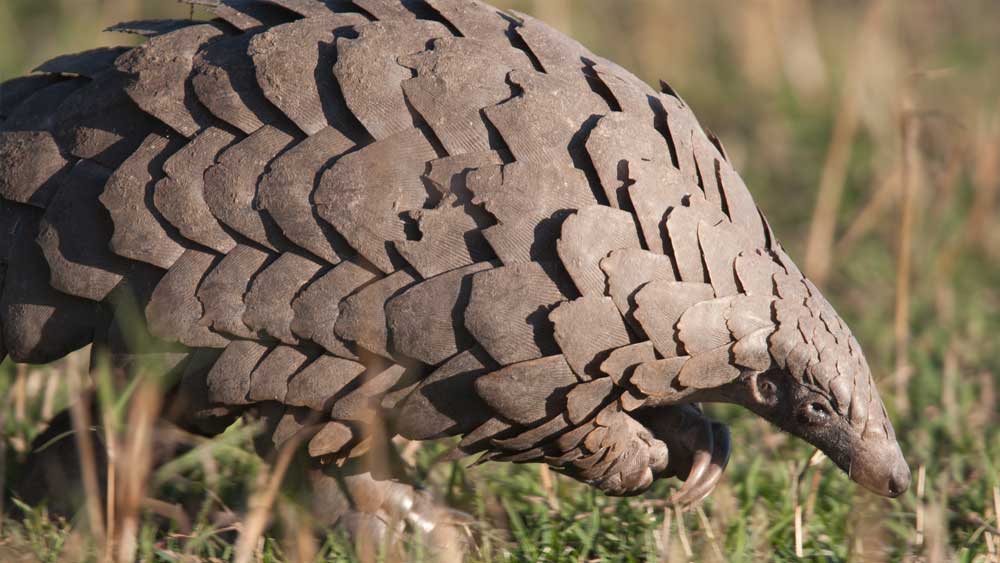Found in southeast Asia and Africa, these creatures look like a cross between a Texas armadillo and an aardvark anteater.2 (When Spanish conquistadores encountered armadillos in Texas, they called them “pigs wearing armor” but soon learned to eat them.)
Pangolins are covered in robust layers of keratin scales that make them look a cross between an artichoke and a pineapple. These formidable scales make up about 20 percent of their body weight.2
After decades of being trafficked for what many assume are its almost-magical qualities in its unusual horn-like scales, it is receiving political protection in China.1
China has removed pangolins from its official list of traditional Chinese medicine treatments, according to reports. The move, reported by China's Health Times newspaper, comes after China raised the animal's protected status to the highest level last week. … All eight species are threatened with extinction.1
And it is the human consumption of pangolins, especially in the Orient, that has so jeopardized their population numbers.
It’s bad enough for pangolins that many enjoy eating their flesh as meat. But worse is the popular belief that the material in pangolin scales is medicinally potent. This has fueled a black market of trafficking pangolin parts.
The scales are highly coveted by traditional Chinese medicine practitioners, while pangolin meat has been seen as a delicacy.1
Accordingly, traditional Oriental medicine and pharmacology threatened pangolin populations. Pangolin scale tissue has thus become a “controlled substance.”
"China's move to phase out pangolin scales from traditional medicines could be the game changer we have been waiting for," [Paul Thomson of ‘Save Pangolins’] said. "We hope China's next move will be to enforce the regulations and work to change consumer behaviour." And Katheryn Wise of animal welfare campaign group, World Animal Protection, said it was "great news" that China had upgraded pangolins to the highest level of protection and removed them from the Chinese Pharmacopoeia.1
Accordingly, the Chinese government has banned that time-honored medical tradition, illustrating what is sometimes called “sociological science.”3 According to Dr. Francis Schaeffer, “sociological science” is the marketing process used for promoting a scientific opinion that was not selected based upon whether it’s scientifically valid. Rather, it is labeled “scientific” based primarily upon political objectives.3
In the case of the endangered pangolin, the official science-promoting objective—as stated by the Chinese government—is to prevent extinction and promote biodiversity by prohibiting pangolin trafficking.
Yet there may be more sensitive factors involved in this controversial decree. Some say pangolins are used in Chinese coronavirus research.4,5 But that explanation is being summarily dismissed. Many say that suggestion must be rejected—just like investigators rejected suspicions of conspiratorial food-poisoning sabotage when a rash episode of salmonella food-poisoning broke out in a small community.6
Meanwhile, pangolins continue slurping up ants and termites, because that is what God designed them to do.2
References
1. Briggs, H. Hope for pangolins as protection boosted in China. BBC News. Posted on bbc.com June 9, 2020, accessed June 10, 2020.
2. Sherwin, F. 2016. The Pangolin: A Mammal with Lizard Scales. Creation Science Update. Posted on ICR.org November 17, 2016, accessed June 10, 2020. Pangolins glorify God just by being pangolins. See Colossians 1:16; Revelation 4:11.
3. Schaeffer, F. A. 1976. How Should We Then Live? Westchester, IL: Crossway Books, 150-225, especially 199-200.
4. “China banned the consumption of live wild animals for food in the wake of the [COVID-19] outbreak, but there are certain exemptions, such as for medicine or fur. Pangolins are in the spotlight as they have been found to carry strains of coronaviruses similar to COVID-19. Scientists are investigating whether trafficked pangolins might have played a role in the [Wuhan] virus moving from animals to humans, but the evidence is unclear.” (Briggs, H. Hope for pangolins as protection boosted in China.)
5. Hassanin, A. Coronavirus Origins: Genome Analysis Suggests Two Viruses May Have Combined. World Economic Forum. Posted on weforum.org March 20, 2020, accessed June 10, 2020.
6. Török, T. J., R. V. Tauxe, et al. 1997. A Large Community Outbreak of Salmonellosis Caused by Intentional Contamination of Restaurant Salad Bars. Journal of the American Medical Association. 278(5): 389-395.
*Dr. Johnson is Associate Professor of Apologetics and Chief Academic Officer at the Institute for Creation Research.













